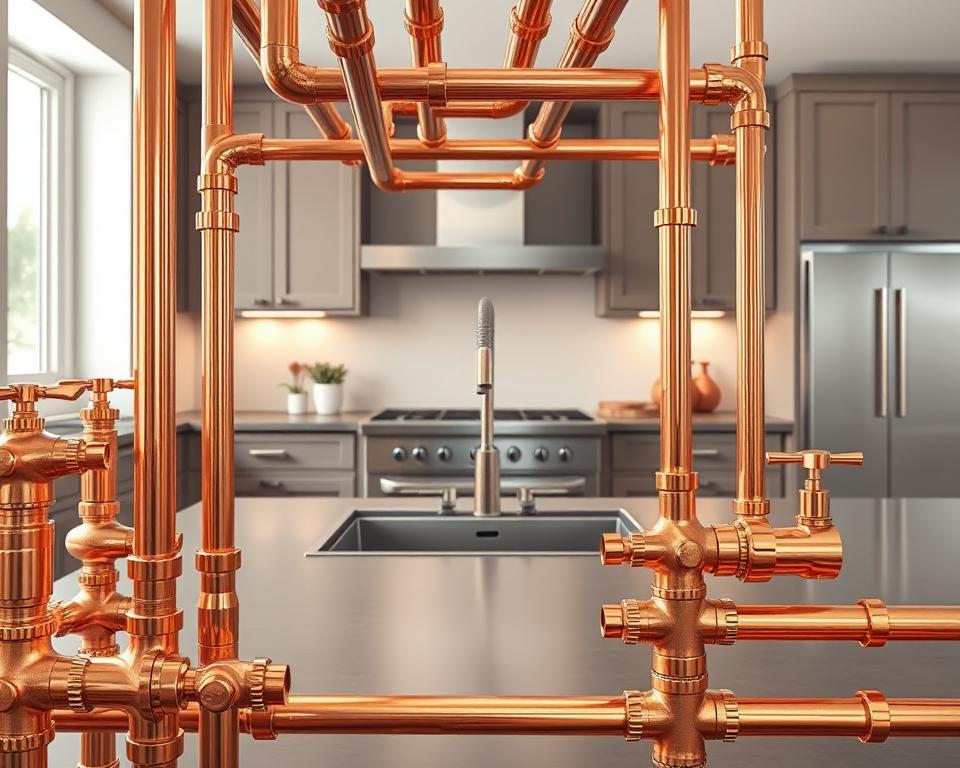Guide to Copper Pipe Water Line Sizes for Your Home
Did you realize that almost 30% of household plumbing problems are caused by pipes of the wrong size? Selecting correct sizes guarantees peak water pressure and overall system performance. This guide helps homeowners understand the basics of sizing for residential projects.
Proper sizing depends on factors like flow requirements and wall thickness. Standard 5/8 copper tubing sizes run between 1/4″ and 8″ across, noted by NPS versus actual exterior measurements. Installation Parts Supply provides professional advice to align your home requirements with code-compliant options.
Thanks to its toughness and rust-resistance, copper is still preferred. Whether retrofitting your setup or installing from scratch, knowing these principles cuts downtime and avoids costly mishaps.
Key Insights

- Accurate sizing stops 30% of usual plumbing issues
- Standard diameters range from 1/4″ to 8″
- Nominal Pipe Size isn’t the same as true OD
- Correct sizing upholds pressure and system efficiency
- Copper offers durability and corrosion resistance
- Specialist support secures regulation adherence
Reasons to Select Copper for Your Plumbing
Long-lasting plumbing begins by choosing the proper material—copper excels for these reasons. Boasting a half-century lifespan and NSF potable-water approval, it’s a go-to for residences. Different from other options, it marries toughness and eco-friendliness.
Toughness and Rust Protection
Thanks to its innate corrosion resistance, copper outperforms PVC/PEX. Its smooth interior maintains water pressure by reducing friction. Practical tests confirm decades of leakless performance.
Installation Parts Supply carries certified quality products suited to your project. While initial costs are higher, the long-term savings from fewer repairs justify the investment.
Flexibility and Freeze Protection
In chilly regions, copper expands just enough when freezing to avoid splits. Such pliability cuts down the danger of expensive freeze harm. Pair it with proper insulation for maximum freeze protection.
Sustainable and Germ-Fighting Properties
Being wholly recyclable, it cuts environmental burden. Its germ-killing traits help safeguard against bacterial contamination. For eco-conscious homeowners, it’s a clear win over plastic alternatives.
Mastering Copper Water Line Measurements and Styles
Pipe sizing can baffle homeowners—this section clarifies it. The industry uses Nominal Pipe Size (NPS), which doesn’t match the actual outer dimensions. For example, a 1/2″ NPS has an outer diameter of 0.625″.
Nominal vs. Actual Pipe Dimensions
Nominal sizes act as identifiers, not actual dimensions. Verify the OD itself when buying. Refer to this chart:
- 1/4″ NPS = 0.375″ OD
- 1/2″ NPS = 0.625″ OD
- 3/4″ NPS = 0.875″ OD
Key Differences Between L, M, and K Types
Residential plumbing relies on three major copper types. Use-case depends on each type’s wall thickness:
- Type L: Light gauge (0.040″ @ 1/2″), perfect for standard homes.
- Type M: Medium-wall (0.050″ for 1/2″), balances cost and durability.
- Type K: Heavy-wall (0.060″ for 1/2″), for high-pressure systems.
For versatility, Installation Parts Supply favors Type M in most setups. Larger diameters (over 2″) often require Type K for irrigation or commercial use.
Type L Copper: Lightweight and Flexible
For homeowners tackling DIY projects, L-type offers unmatched flexibility. A slender wall cuts both heft and expense without sacrificing dependability. Comes both in straight bars and flexible coils for HVAC to DWV work.
Where L-Type Excels and Falls Short
Best suited to systems under low pressure. A 0.040″ gauge suits:
- HVAC refrigerant lines
- Drain-waste-vent (DWV) systems
- Residential water supply (below 80 PSI)
Not for high PSI—opt for Type K if stress exceeds limits. Coils (max 50ft) ease around corners but must be bent cautiously to avoid kinks.
Sizing Options and Installation Tips
Choose from 1/4″ to 8″ diameters, with these popular options:
| Form | Max Length | Best For |
|---|---|---|
| Rigid | 20ft | Straight runs |
| Coiled | 50ft | Tight spaces |
Installation Parts Supply recommends rigid forms for beginners—they’re easier to cut and solder. For large projects, coiled options reduce joint counts, saving time and potential leak points.
Type M Copper Pipes: The Residential Standard
With cost and strength balanced, M-type is ideal for today’s residences. A mid-thickness wall manages daily use without breaking the bank. Approved by NSF for water and gas, it works in kitchens, baths, and heating.
M-Type Best Applications
Perfect for mixed hot/cold service, keeping water pressure uniform. Use 12ft rigid for long stretches, 100ft coils for narrow pathways. Typical uses cover:
- Drinking water distribution
- Medical gas lines (oxygen, nitrous oxide)
- HVAC refrigerant lines
Thickness vs. Pressure for M-Type
Sits midway between L and K in gauge and strength. With 0.050″ walls, it tolerates up to 150 PSI without failure. Review these benchmarks:
| Type | Wall Thickness (1/2″) | Max Pressure | Best For |
|---|---|---|---|
| L | 0.040″ | 80 PSI | Low-pressure DWV |
| M | 0.050″ | 150 PSI | Residential supply |
| K | 0.060″ | 200 PSI | Irrigation |
Installation Parts Supply keeps M-type stocked across standard diameters. For gas lines, pair with flare fittings to prevent leaks. Allow slight expansion gaps in hot water runs to accommodate thermal movement.
Type K Copper for Tough Applications
Under the toughest conditions, K-type provides exceptional endurance. Heavy walls plus high PSI capacity suit it to industrial or buried lines. It withstands both compression and corrosion better than lighter gauges.
K-Type for High PSI & Irrigation
K-type excels where others fail. With 0.060″ walls, it tolerates 200 PSI, suitable for:
- Underground irrigation systems
- Commercial HVAC refrigerant lines
- Fire sprinkler networks
When burying, Installation Parts Supply suggests at least 18″ cover. Pair with compression fittings torqued to 25 ft-lbs to prevent leaks.
How to Choose Rigid or Coiled K-Type
Pick rigid or coil depending on application. Rigid 12ft for long stretches; coils 50ft for complex paths. See their differences:
| Form | Best For | Limitations |
|---|---|---|
| Rigid | High-pressure mains | Requires more fittings |
| Coiled | Trenchless installations | Risk of kinks if bent sharply |
In irrigation layouts, allow 10% for thermal growth. Avoid bending rigid forms without a tube bender—kinks reduce flow efficiency.
Copper Pipe Installation & Maintenance
Proper installation techniques ensure decades of leak-free performance in plumbing systems. DIYers or professionals alike benefit from mastering these fundamentals. Follow these methods to achieve secure, long-lasting results.
Connection Options Compared
Select the joining style that fits your task. Permanent joints use heat or compression, while temporary options allow adjustments. See which suits you best:
| Method | Pros | Cons | Best For |
|---|---|---|---|
| Soldering | Strong, permanent | Requires skill | Water supply lines |
| Compression | No heat needed | Bulky fittings | Tight spaces |
| Push-Fit | Quick installation | Higher cost | Emergency repairs |
Soldering Procedure
For a flawless joint, follow these steps:
- Thoroughly clean with emery cloth.
- Coat each piece evenly with flux.
- Apply torch heat until you hear the flux hiss.
- Touch solder to the fittings—capillary action draws it in.
Protective gloves and fresh air are a must. Installation Parts Supply stocks lead-free solder for drinking water safety.
Leak Prevention & Freeze Protection
Use foam insulation on pipes in cold spots. Use foam sleeves for pipes running through exterior walls. To fix minor issues:
- Inspect fittings yearly for green patina indicating leaks.
- Bracket horizontal stretches every 32 inches to stop drooping.
- Choose freeze-safe taps in winter-prone areas.
Yearly checks spot small problems early. Stash wrenches, cutters, and Teflon tape in your kit for fast repairs.
Conclusion: Selecting the Right Copper Pipe with Installation Parts Supply
With good planning, your plumbing will last—remember these highlights. Choose proper size and type for lasting durability. Keep in mind:
- M-type works for most residences; K fits heavy-duty applications
- Proper sizing maintains pressure and prevents leaks
- Freeze protection is critical in cold climates
Get specialist advice from Installation Parts Supply to streamline decisions. All products are certified and backed by quality assurances for flawless plumbing systems.
For support, grab our free guides or arrange a consultation right away. First-time buyers get exclusive discounts—start your project right!

